[English] 日本語
 Yorodumi
Yorodumi- PDB-2lkt: Solution structure of N-terminal domain of human TIG3 in 2 M UREA -
+ Open data
Open data
- Basic information
Basic information
| Entry | Database: PDB / ID: 2lkt | ||||||
|---|---|---|---|---|---|---|---|
| Title | Solution structure of N-terminal domain of human TIG3 in 2 M UREA | ||||||
 Components Components | Retinoic acid receptor responder protein 3 | ||||||
 Keywords Keywords | HYDROLASE / TIG3 / human tumor suppressor II family / NlpC/P60 | ||||||
| Function / homology |  Function and homology information Function and homology informationpositive regulation of protein-glutamine gamma-glutamyltransferase activity / phosphatidylethanolamine acyl-chain remodeling / N-acylphosphatidylethanolamine metabolic process / phospholipase A1 / Acyl chain remodelling of PE / phospholipase A1 activity / N-acyltransferase activity / A2-type glycerophospholipase activity / positive regulation of keratinocyte differentiation / phospholipase A2 ...positive regulation of protein-glutamine gamma-glutamyltransferase activity / phosphatidylethanolamine acyl-chain remodeling / N-acylphosphatidylethanolamine metabolic process / phospholipase A1 / Acyl chain remodelling of PE / phospholipase A1 activity / N-acyltransferase activity / A2-type glycerophospholipase activity / positive regulation of keratinocyte differentiation / phospholipase A2 / acyltransferase activity / lipid catabolic process / phospholipid metabolic process / Transferases; Acyltransferases; Transferring groups other than aminoacyl groups / negative regulation of cell population proliferation / membrane / cytosol / cytoplasm Similarity search - Function | ||||||
| Biological species |  Homo sapiens (human) Homo sapiens (human) | ||||||
| Method | SOLUTION NMR / simulated annealing | ||||||
| Model details | lowest energy, model 1 | ||||||
 Authors Authors | Wang, L. / Yu, W. / Xia, B. | ||||||
 Citation Citation |  Journal: Biomol.Nmr Assign. / Year: 2012 Journal: Biomol.Nmr Assign. / Year: 2012Title: (1)H, (13)C, and (15)N resonance assignments of the N-terminal domain of human TIG3 Authors: Wang, L. / Yu, W. / Ren, X. / Lin, J. / Jin, C. / Xia, B. | ||||||
| History |
|
- Structure visualization
Structure visualization
| Structure viewer | Molecule:  Molmil Molmil Jmol/JSmol Jmol/JSmol |
|---|
- Downloads & links
Downloads & links
- Download
Download
| PDBx/mmCIF format |  2lkt.cif.gz 2lkt.cif.gz | 762.9 KB | Display |  PDBx/mmCIF format PDBx/mmCIF format |
|---|---|---|---|---|
| PDB format |  pdb2lkt.ent.gz pdb2lkt.ent.gz | 640.8 KB | Display |  PDB format PDB format |
| PDBx/mmJSON format |  2lkt.json.gz 2lkt.json.gz | Tree view |  PDBx/mmJSON format PDBx/mmJSON format | |
| Others |  Other downloads Other downloads |
-Validation report
| Summary document |  2lkt_validation.pdf.gz 2lkt_validation.pdf.gz | 409.3 KB | Display |  wwPDB validaton report wwPDB validaton report |
|---|---|---|---|---|
| Full document |  2lkt_full_validation.pdf.gz 2lkt_full_validation.pdf.gz | 508.2 KB | Display | |
| Data in XML |  2lkt_validation.xml.gz 2lkt_validation.xml.gz | 36.2 KB | Display | |
| Data in CIF |  2lkt_validation.cif.gz 2lkt_validation.cif.gz | 63.4 KB | Display | |
| Arichive directory |  https://data.pdbj.org/pub/pdb/validation_reports/lk/2lkt https://data.pdbj.org/pub/pdb/validation_reports/lk/2lkt ftp://data.pdbj.org/pub/pdb/validation_reports/lk/2lkt ftp://data.pdbj.org/pub/pdb/validation_reports/lk/2lkt | HTTPS FTP |
-Related structure data
| Similar structure data | |
|---|---|
| Other databases |
- Links
Links
- Assembly
Assembly
| Deposited unit | 
| |||||||||
|---|---|---|---|---|---|---|---|---|---|---|
| 1 |
| |||||||||
| NMR ensembles |
|
- Components
Components
| #1: Protein | Mass: 14050.886 Da / Num. of mol.: 1 / Fragment: NlpC/P60 structural domain Source method: isolated from a genetically manipulated source Source: (gene. exp.)  Homo sapiens (human) / Gene: TIG3 / Production host: Homo sapiens (human) / Gene: TIG3 / Production host:  References: UniProt: Q9UL19, Hydrolases; Acting on ester bonds; Carboxylic-ester hydrolases |
|---|
-Experimental details
-Experiment
| Experiment | Method: SOLUTION NMR Details: Solution structure of N-terminal domain of human TIG3 | ||||||||||||||||||||||||||||||||||||||||||||||||||||
|---|---|---|---|---|---|---|---|---|---|---|---|---|---|---|---|---|---|---|---|---|---|---|---|---|---|---|---|---|---|---|---|---|---|---|---|---|---|---|---|---|---|---|---|---|---|---|---|---|---|---|---|---|---|
| NMR experiment |
|
- Sample preparation
Sample preparation
| Details | Contents: 0.5 mM [U-13C; U-15N] TIG3N protein-1, 50 mM sodium phosphate-2, 50 mM sodium chloride-3, 20 mM DTT-4, 2 M urea-5, 95 % H2O-6, 5 % [U-2H] D2O-7, 0.01 % DSS-8, 95% H2O/5% D2O Solvent system: 95% H2O/5% D2O | ||||||||||||||||||||||||||||||||||||
|---|---|---|---|---|---|---|---|---|---|---|---|---|---|---|---|---|---|---|---|---|---|---|---|---|---|---|---|---|---|---|---|---|---|---|---|---|---|
| Sample |
| ||||||||||||||||||||||||||||||||||||
| Sample conditions | Ionic strength: 100 / pH: 7 / Pressure: 1 atm / Temperature: 308 K |
-NMR measurement
| NMR spectrometer |
|
|---|
- Processing
Processing
| NMR software |
| ||||||||||||||||||||||||||||||||||||||||||||
|---|---|---|---|---|---|---|---|---|---|---|---|---|---|---|---|---|---|---|---|---|---|---|---|---|---|---|---|---|---|---|---|---|---|---|---|---|---|---|---|---|---|---|---|---|---|
| Refinement | Method: simulated annealing / Software ordinal: 1 / Details: using AMBER ff03 force filed refinement | ||||||||||||||||||||||||||||||||||||||||||||
| NMR constraints | NOE constraints total: 3218 / NOE intraresidue total count: 1144 / NOE long range total count: 454 / NOE medium range total count: 233 / NOE sequential total count: 509 | ||||||||||||||||||||||||||||||||||||||||||||
| NMR representative | Selection criteria: lowest energy | ||||||||||||||||||||||||||||||||||||||||||||
| NMR ensemble | Conformer selection criteria: structures with the lowest energy Conformers calculated total number: 100 / Conformers submitted total number: 20 / Maximum lower distance constraint violation: 0.099 Å / Maximum upper distance constraint violation: 0.231 Å / Representative conformer: 1 |
 Movie
Movie Controller
Controller


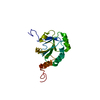

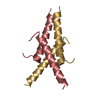
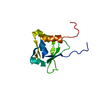
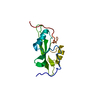

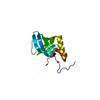

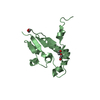

 PDBj
PDBj

 HSQC
HSQC